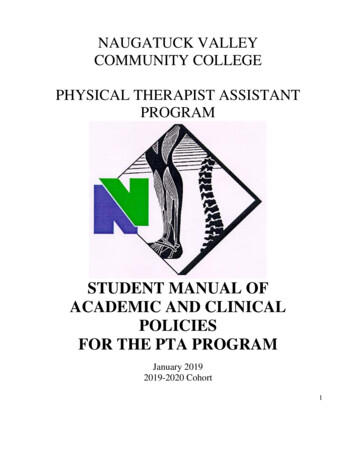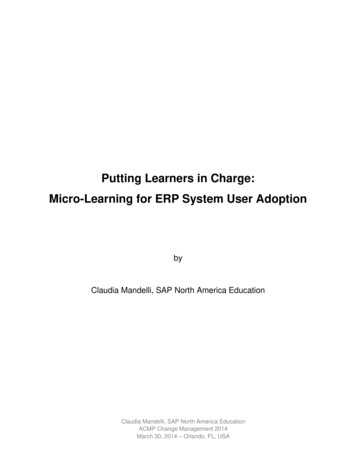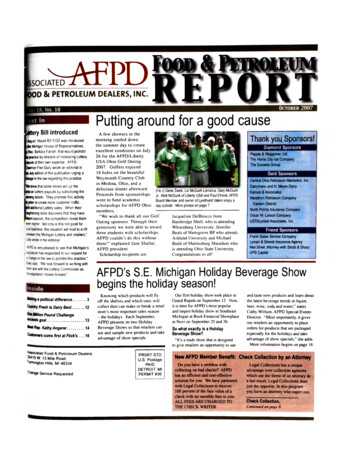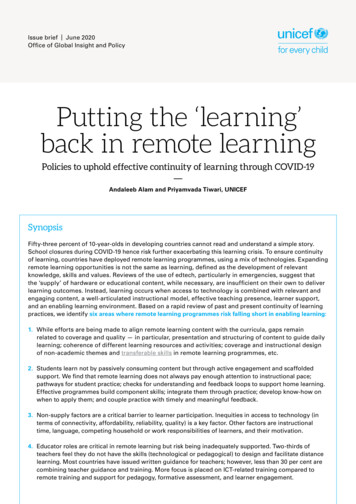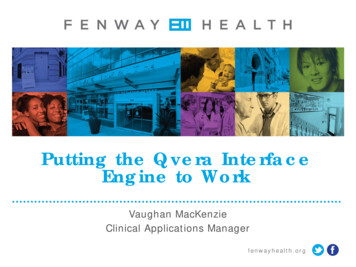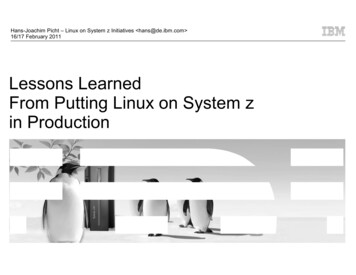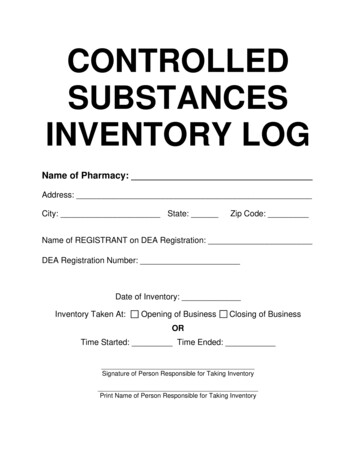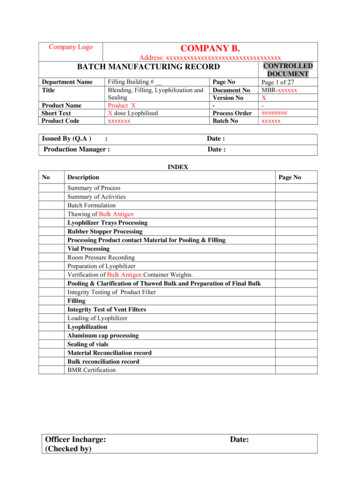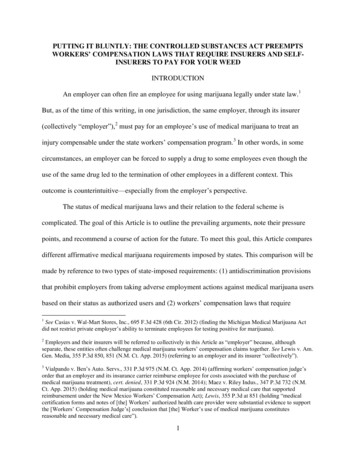
Transcription
PUTTING IT BLUNTLY: THE CONTROLLED SUBSTANCES ACT PREEMPTSWORKERS’ COMPENSATION LAWS THAT REQUIRE INSURERS AND SELFINSURERS TO PAY FOR YOUR WEEDINTRODUCTIONAn employer can often fire an employee for using marijuana legally under state law.1But, as of the time of this writing, in one jurisdiction, the same employer, through its insurer(collectively “employer”),2 must pay for an employee’s use of medical marijuana to treat aninjury compensable under the state workers’ compensation program.3 In other words, in somecircumstances, an employer can be forced to supply a drug to some employees even though theuse of the same drug led to the termination of other employees in a different context. Thisoutcome is counterintuitive—especially from the employer’s perspective.The status of medical marijuana laws and their relation to the federal scheme iscomplicated. The goal of this Article is to outline the prevailing arguments, note their pressurepoints, and recommend a course of action for the future. To meet this goal, this Article comparesdifferent affirmative medical marijuana requirements imposed by states. This comparison will bemade by reference to two types of state-imposed requirements: (1) antidiscrimination provisionsthat prohibit employers from taking adverse employment actions against medical marijuana usersbased on their status as authorized users and (2) workers’ compensation laws that require1See Casias v. Wal-Mart Stores, Inc., 695 F.3d 428 (6th Cir. 2012) (finding the Michigan Medical Marijuana Actdid not restrict private employer’s ability to terminate employees for testing positive for marijuana).2Employers and their insurers will be referred to collectively in this Article as “employer” because, althoughseparate, these entities often challenge medical marijuana workers’ compensation claims together. See Lewis v. Am.Gen. Media, 355 P.3d 850, 851 (N.M. Ct. App. 2015) (referring to an employer and its insurer “collectively”).3Vialpando v. Ben’s Auto. Servs., 331 P.3d 975 (N.M. Ct. App. 2014) (affirming workers’ compensation judge’sorder that an employer and its insurance carrier reimburse employee for costs associated with the purchase ofmedical marijuana treatment), cert. denied, 331 P.3d 924 (N.M. 2014); Maez v. Riley Indus., 347 P.3d 732 (N.M.Ct. App. 2015) (holding medical marijuana constituted reasonable and necessary medical care that supportedreimbursement under the New Mexico Workers’ Compensation Act); Lewis, 355 P.3d at 851 (holding “medicalcertification forms and notes of [the] Workers’ authorized health care provider were substantial evidence to supportthe [Workers’ Compensation Judge’s] conclusion that [the] Worker’s use of medical marijuana constitutesreasonable and necessary medical care”).1
employers to reimburse the cost of medical marijuana treatment prescribed to an injuredemployee. Specifically, this Article argues that the federal regulatory scheme created by theControlled Substances Act (CSA)4 should not preempt antidiscrimination provisions imposed bystates that prohibit discrimination based on a workers’ status as a medical marijuana user;however, a workers’ compensation claim requiring the employer to reimburse the cost of medicalmarijuana should be preempted under the CSA.This Article proceeds in three parts. Part I provides a brief background of medicalmarijuana regulation in the United States, noting its development and current status. Part IIintroduces the relationship between the federal CSA and various kinds of state medicalmarijuana laws, arguing that—unlike other medical marijuana laws that “authorize” the drug’suse—antidiscrimination provisions should not be preempted under current preemption doctrine.Part III continues the argument initially developed in Part II by drawing a comparison betweenantidiscrimination provisions, which should not be preempted, and certain workers’compensation schemes, which should be preempted to the extent that they require an employer toreimburse the cost of an employee’s medical marijuana under the state workers’ compensationprogram. The Author then briefly offers closing remarks and recommendations for the future.I.A.BACKGROUNDMarijuana in the United States: A Brief HistoryIn their seminal article on the history of marijuana in the United States, ProfessorsBonnie and Whitebread explain that “once a spark of truth ignites the public opinion process, theauthority of time will not stay the flames of controversy.[T]he fire may spread.So it has beenwith marijuana.”5421 U.S.C. § 801 (2012).2
Marijuana was legal to both grow and consume for most of American history.6 In theearly 1900s, however, states started legislatively restricting access to marijuana and other drugs.7Between 1907, when California became the first state to outlaw marijuana,8 and 1931, twentytwo states passed restrictions banning marijuana to various degrees.9 At the federal level, theHarrison Act of 191410 was the legislative turning point “imposing a stamp of illegitimacy onmost narcotics use.”11 While the Harrison Act created a registration and tax mechanism designedto capture all of the importers, producers, and dealers of opium, cocaine, or their derivatives,12marijuana fell below the national public policy radar until the Marihuana Tax Act of 1937.13 The“uncontroversial” Marihuana Tax Act was “hastily drawn, heard, debated, and passed.”14Interestingly, both proponents and opponents believed medical studies should be completed totest marijuana’s medical usefulness,15 but following “kneejerk responses uninformed by5Richard J. Bonnie & Charles H. Whitebread, II, The Forbidden Fruit and the Tree of Knowledge: An Inquiry intothe Legal History of American Marijuana Prohibition, 56 VA. L. REV. 971, 974 (1970).6See Michael Vitiello, Proposition 215: De Facto Legalization of Pot and the Shortcomings of Direct Democracy,31 U. MICH. J.L. REFORM 707, 748-51 (1998). In general, “[m]arijuana’s recorded use as medicine goes back nearly5,000 years.” DEL. CODE ANN. tit. 16 § 4901A(a) (West, Westlaw through 80 Del. Laws 2016, ch. 243).7See Bonnie & Whitebread, supra note 5, at 1010 (describing marijuana restrictions before 1932).8Robert S. Goldsmith et al., Medical Marijuana in the Workplace: Challenges and Management Options forOccupational Physicians, Journal of Occupational and Environmental Medicine, May 2015, at 519, available 963/pdf/joem-57-518.pdf.9See Bonnie & Whitebread, supra note 5, at 1010.10Harrison Narcotics Act of 1914, Pub. L. No. 63-223, 38 Stat. 785, repealed by Comprehensive Drug AbusePrevention and Control Act of 1970, Pub. L. No. 91-513, 84 Stat. 1236 (codified as amended at 21 U.S.C. §§ 801971 (2012)).11Bonnie & Whitebread, supra note 5, at 987.12See id.13See id. at 1010.14Id. at 1062.15See Vitiello, supra note 6, at 749-51.3
scientific study,”16 Congress followed the lead of the United States Commissioner of Narcotics,Harry J. Anslinger, who argued “[m]arijuana [was] an addictive drug which produce[d] in itsusers insanity, criminality, and death,” to effectively ban the drug.17 Even though the MarijuanaTax Act only prohibited “non-medicinal and unlicensed possession or sale of marijuana,”18 it“imposed such onerous registration and recordkeeping procedures on doctors and wholesaledealers.that it put an end to the market in medical cannabis.”19 Thirty years later, under theauspices of President Nixon’s “war on drugs,”20 Congress adopted what is now the CSA, whichlies at the center of most medical marijuana cases before courts.21B.The Revolution: Increasing Acceptance and Current IssuesLike Dr. Sanjay Gupta,22 “I see signs of revolution everywhere.”23 While only 12 percentof Americans approved of marijuana use in 1969, today that number has increased to 58 percentsupporting marijuana legalization in general24 and 77 percent supporting the drug’s medicinal16Bonnie & Whitebread, supra note 5, at 1010.17See Vitiello, supra note 6, at 749.18JAMES P. GRAY, WHY OUR DRUG LAWS HAVE FAILED AND WHAT WE CAN DO ABOUT IT: A JUDICIALINDICTMENT OF THE WAR ON DRUGS 25 (2001).19Ruth C. Stern & J. Herbie DiFonzo, The End of the Red Queen’s Race: Medical Marijuana in the New Century,27 QUINNIPIAC L. REV. 673, 686 (2009).20See id. at 752.21Controlled Substances Act of 1970, Pub. L. No. 91-513, 84 Stat. 1236 (codified at 21 U.S.C. § 801 (2012)).22Dr. Sanjay Gupta, a practicing neurosurgeon, is an “Emmy -award winning chief medical correspondent forCNN.” Dr. Sanjay Gupta, Full Biography, CNN, bout (lastvisited May 5, 2016).23Dr. Sanjay Gupta, Dr. Sanjay Gupta: It’s Time for a Medical Marijuana Revolution, CNN (April 20, al-marijuana-revolution-sanjay-gupta/ (noting the increasingapproval for medical marijuana).24See Jeffrey M. Jones, In U.S., 58% Back Legal Marijuana Use, GALLUP (Oct. 21, -marijuana.aspx.4
use.25 People from all avenues of life are joining the political melee: some are medical marijuanausers; some are activists; and others are both. People like Irvin Henry Rosenfeld, a stockbrokerand advocate claiming to be one of a few medical marijuana users smoking 12 marijuanacigarettes every day under the auspices of a federal prescription, are rare.26 But others, like theone million medical marijuana users throughout the United States, are much more common.27Labor organizations have endorsed medical marijuana legislation,28 and even congressionalrepresentatives have been more involved in recent years.29 Some Members of Congress, notingsupport for medical marijuana legalization dating back to 1997, are urging for medicinallegalization, especially for injured soldiers.30 At least one GOP congressman openly admittedthat he turned to “medical marijuana to help deal with arthritis pain” while in office.31Amidst the tumultuous political climate lies “one of the most important federalismconflicts in a generation.”32 This is especially true in the context of labor and employment law.25See Majority Now Supports Legalizing Marijuana, PEW RESEARCH CENTER (April 4, 2013), -supports-legalizing-marijuana/.26See Conant v. Walters, 309 F.3d 629, 649 (9th Cir. 2002) (Kozinski, J., concurring). See also Meghan McRoberts,Irvin Rosenfeld: Ft. Lauderdale Man Smokes Medical Marijuana Legally for Decades, WPTV (Oct. 22, lly-for-decades.27See Number of Legal Medical Marijuana Patients, PROCON (Mar. 1, urce.php?resourceID 005889.28See, e.g., Laura Nahmias, AFL-CIO Backs Medical Marijuana Bill, POLITICO NEW YORK (June 11, ill (detailing theAFL-CIO’s support of the Compassionate Care Act in New York).29See Dr. Sanjay Gupta, supra note 23 (noting “politicians have a hard time winning elections on the issue ofmarijuana but less difficulty losing them”).30See, e.g., Representative Dina Titus, Puff, Puff, Pass.That Law: The Changing Legislative Environment ofMedical Marijuana Policy, 53 HARV. J. ON LEGIS. 39, 57-58 (2016) (arguing that “the federal government shouldfollow the path set forth by many states in legalizing medical marijuana”).31Christopher Ingraham, A GOP Congressman Says He Used Medical Marijuana While in Office, WASHINGTONPOST (May 25, 2016), na-while-in-office/.32Erwin Chemerinsky et al., Cooperative Federalism and Marijuana Regulation, 62 UCLA L. REV. 74, 77 (2015).5
Twenty five states, the District of Columbia, and Guam have legalized comprehensive marijuanaprograms for either medical or recreational purposes (or both), and 17 states allow “‘low THC,high cannabidiol (CBD)’ products for medical reasons in limited situations or as a legaldefense.”33 But marijuana is illegal under federal law.34 States in recent years, noting a need toprovide safe access to medication, have relied on their traditional police powers35 to regulatehealth and safety within their borders to protect Americans whose only hope for living a normallife is a federally proscribed medicine deemed to have “no currently accepted medical use intreatment,” and no acceptable safe use—even “under medical supervision.”36Due to the drug’s illegal federal status, employers have had relatively little difficultyterminating medical marijuana-using employees who violate zero-tolerance drug-free workplacepolicies37—even a lawful activities statute could not protect a worker from termination when heused his medical marijuana while off-duty and in compliance with the state medical marijuanalaw.38 But employers should not rest on their zero-tolerance laurels. Thus far, in at least onejurisdiction (others could soon follow), an employer may find itself legally capable of firing oneemployee who tests positive for medical marijuana on the job, but the same employer might berequired to reimburse the cost of paying for a different injured employee’s medical marijuana33State Medical Marijuana Laws, NCSL (June 8, 2016), arijuana-laws.aspx.3421 U.S.C. § 812 (2012).35See Dean M. Nickles, Note, Federalism and State Marijuana Legislation, 91 NOTRE DAME L. REV. 1253, 1254-55(2016) (noting that states have passed medical marijuana laws under their “police power,” which “protect[s] thehealth, safety, an welfare of their citizens”); Gibbons v. Ogden, 22 U.S. 1, 78 (1824) (police powers include “healthlaws of every description”).3621 U.S.C. § 812.37See Casias v. Wal-Mart Stores, Inc., 695 F.3d 428 (6th Cir. 2012) (finding the Michigan Medical Marijuana Actdid not restrict private employer’s ability to terminate
medical marijuana treatment), cert. denied, 331 P.3d 924 (N.M. 2014); Maez v. Riley Indus., 347 P.3d 732 (N.M. Ct. App. 2015) (holding medical marijuana constituted reasonable and necessary medical care that supported reimbursement under the New Mexico Workers’ Compensation Act); Lewis, 355 P.3d at 851 (holding “medical certification forms and notes of [the] Workers’ authorized health .



